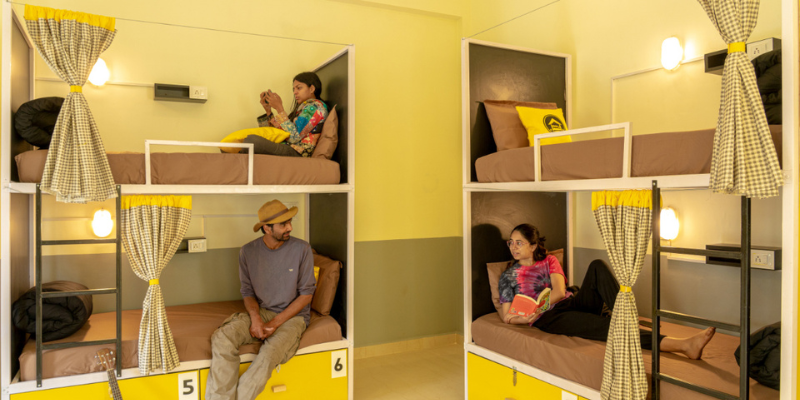Startup
This gym chain co-founded by Preity G Zinta and Shubman Gill aims to fuse cricket and fitness to drive wellness

Cricket is more than just a sport in India; it’s a cultural phenomenon that resonates with many, across every nook and corner of the country. Popularity and participation apart, a lot of money is also being pumped into the sport.
According to ISPO, which hosts trade shows for the sports business, cricket accounted for 85% of India’s spending on sports in 2022.
However, when it comes to world-class training facilities, especially indoor amenities, there seems to be a gap.
Seeing an opportunity in this, Australian businessmen Deke Smith and Mark Sellar recently announced their venture ‘DRIVE FITT’ in the country. Bollywood actress Preity G Zinta and Indian cricketer Shubman Gill are co-founders and part of the founding shareholders at DRIVE FITT; they also hold significant equity in the company.
Started with an initial investment of over $2 million by Sellar and Smith, DRIVE FITT is a 24/7 member-based gym facility that offers cricket training facilities integrated with gym amenities. It is targeted at aspiring cricketers, those who play cricket in the weekends, fitness enthusiasts, and anyone looking for fun ways to incorporate fitness into their lives.
Smith and Sellar’s interest in India stems from the growing demand for high-quality fitness facilities and the country’s vast and young population, which presents a significant opportunity for impact in the fitness industry.
“The lack of world-class indoor cricket training facilities and restriction of good quality facilities to just cricket academy participants, and not accessible to the general public or weekend cricketers, drove the foundation of the brand,” says Smith, CEO of DRIVE FITT, in an interaction with YourStory.
“We saw two significant trends in India: the booming fitness industry and the nation’s unparalleled passion for cricket. We saw an opportunity to create something unique by blending these two elements into a concept that’s both innovative and accessible,” he adds.
During the launch of the brand, Zinta said, “DRIVE FITT represents a unique fusion of fitness and cricket, two passions that resonate deeply with me and a lot of people in India. Our mission is to create an inclusive environment where people of all ages and fitness levels can come together to train, have fun, and stay healthy.”
DRIVE FITT will open its first company-owned facility in Gurugram in October, followed by another facility in Noida in November. Going forward, it aims to establish franchises across India; it is eyeing 300 franchises in three years.
Commenting on what drove him to associate himself with DRIVE FITT, Gill said, in a statement, “The seed of DRIVE FITT was my experience of a lack of accessible, quality training facilities. Growing up, this meant hours wasted in commuting between home, the pitch, and the gym. DRIVE FITT will change this with a unique space that integrates world-class gym and fitness facilities with cricket-infused training.”
The founders of DRIVE FITT understand the vital link between physical and mental well-being, and their goal is to help individuals achieve their fitness and wellness goals.
“Providing people with a community, a place to train, have fun, and stay fit and healthy whilst playing a sport will inevitably improve mental health. The integration of physical exercise and social interaction in a supportive environment helps reduce stress, boost mood, and enhance overall mental well-being,” explains Smith.

DRIVE FITT Co-founders L:R – Deke Smith(CEO) ; Preity G Zinta; Shubman Gill; Mark Sellar (Chairman)
What it offers
Understanding the diverse schedules of people, DRIVE FITT functions 24/7 to offer a flexible and convenient environment for workout. It offers state-of-the-art cricket training facilities, yoga studios, and amenities for comprehensive strength, conditioning, and cardio training.
Daily, weekly, monthly, quarterly, and annual subscription plans are offered to cater to various needs and preferences. The daily pass costs around Rs 1,000, while monthly memberships start at Rs 7,000; annual membership can go up to Rs 35,000. Family memberships are also available for two adults and one/two children.
The facility offers personal training, cricket coaching, and group classes–all using cricket-infused training methods developed by co-founder Shubman Gill, Australian cricketer Chris Lynn, and former Aussie fast-bowler Ryan Harris, who are shareholders in the venture.
Apart from these, DRIVE FITT also offers yoga sessions.
“Aspiring cricketers receive professional training, while fitness enthusiasts enjoy a comprehensive workout experience using the best sporting technology and equipment,” says Smith.
Members will also have access to the DRIVE FITT mobile app, which allows them to book cricket and fitness training sessions and nets sessions and offers meal plans.
What everyone brings to the table
Smith is an accomplished businessman with nearly two decades of experience across sales, marketing and operations at some of Australia’s largest companies. He now serves as the managing director of Smith Agency RE, a real estate sales and marketing firm.
Sellar, a seasoned entrepreneur, is the founder of Sellar Capital, a family-owned investment company. His investments extend into medical advancements, sports ventures, pioneering startups, and education initiatives.
Lynn is a premier T20 batsmen who brings to the table understanding and knowledge of the game, along with his unique skill-set in short-form batting. Harris will contribute his expertise in developing coaching programmes in cricket and fitness. He will also offer insights on becoming a world-class fast bowler.
Sellar and Smith had always wanted to work with Zinta, whom they believe has fantastic business acumen and knowledge of the cricket business.
With over 15 years of experience owning and running an IPL team, Zinta will ensure DRIVE FITT offers excellent opportunities for franchise owners, remarks Sellar.
Gill, with his immense cricketing skills and passion for health, strength, and fitness, has significantly shaped the services offered at DRIVE FITT.
“Gill has played a key role in selecting gym equipment, developing training regimes and programmes available in the app, and enhancing the cricket facilities and offerings at DRIVE FITT,” says Sellar.
The venture has also onboarded Nikhil Kakkar, former COO of Gold’s Gym, as its chief operating officer. Kakkar, who had 16 years of experience at Gold’s Gym, will spearhead the company’s operations and franchising efforts.
Driving forward
DRIVE FITT aims to create strong brand awareness across the country through targeted marketing campaigns and partnerships, alongside store launches.
“By establishing these initial facilities and building a robust brand presence, we are confident in laying a solid foundation for future growth and inspiring more people to embrace a healthy lifestyle through our unique cricket and fitness integration,” signs off Sellar.
Startup
India’s QR soundbox boom: how merchant acquirers can ride the offline payment wave

“UPI account par 18 rupay prapt hue” or “Rs 18 has been deposited to your UPI account.” Just when it seemed like India’s digital payments journey had reached its peak, QR codes paired with soundboxes emerged, showing us that we have only begun.
The familiar chime of these soundboxes now unites millions of UPI users across the country. Together, soundboxes and QR codes offer seamless, real-time payment confirmations, which makes them indispensable resources for merchants.
Why QR-based soundboxes work in India
The adoption of QR codes is rapidly expanding over conventional Point of Sale (PoS) devices, not only in Tier I cities, but also in Tier II, Tier III, and rural areas. In fact, QR code deployment increased by 34% in FY24 to over 350 million. PWC attributes the shift to factors such as high rental costs, MDR (merchant discount rates), and the operational complexity of maintaining PoS machines.
The low cost of QR payment acceptance has also compounded challenges. Merchants may use QR codes from different providers. For merchant acquirers, this translates into higher incidence of churn and an escalation in the overall cost of acquisition, as they invest in both technology and on-the-ground sales efforts.
Hence, QR paired with soundboxes present an opportunity to strengthen merchant loyalty in offline acquisition. Instead of standalone QRs, merchants increasingly prefer QR paired with Soundboxes, as instant and reliable payment confirmations are essential — particularly for those with high foot traffic. Consider a busy sweets shop in Delhi during the holiday season. Now, sellers don’t have to wait for confirmations of UPI payments, which might lead to delays. These devices simplify the process for both customers and merchants by providing real-time, audible payment confirmation. Additionally, it also provides an additional level of security by diminishing the possibility of non-payments and fraud at checkout.
The game changer in offline merchant acquisition
According to a recent Cognitive Market Research report, India’s merchant acquiring market reached $611.21 million in 2024 and projected to grow at a CAGR of 12% between 2024-2031, driven by regulatory support. Another report by Kearney highlights that retail digital payments is expected to double, from $3.6 trillion in FY24 to $7 trillion by FY30.
As this growth unfolds, the challenge for acquirers—both banks and merchant aggregators — will be how they capture this opportunity. Given the operationally intensive nature of the business scaling profitably is far from simple. For example, if an acquirer wants to offer Soundboxes to its merchants, they need a reliable device vendor, manage inventory, across remote merchant locations nationwide, partner with logistics providers for shipment, test every dispatched unit, and establish merchant support operations. Setting up this infrastructure could delay their go-to-market, increasing the risk of losing merchant-led businesses to competitors. The traditional ‘do-it- yourself’ model, where acquirers handle everything from merchant acquisition to backend operations, is increasingly unsustainable and non-core to a merchant acquirer’s business.
Offline Payments as a Service (PaaS) simplify payment operations for acquirers by handling the entire merchant and transaction lifecycle. This includes onboarding, device management, and transaction processing. By integrating business and tech operations with advanced payment software, PaaS solutions allow acquirers to focus on strategic growth rather than operational complexities.
Through a managed services model, acquirers can significantly reduce merchant acquisition costs by digitizing the onboarding process and streamlining due diligence. They also handle device logistics, including shipping, inventory, and support. For example, a merchant in a remote rural area needing assistance with a device like SoundBox receives instant support through the managed services provider, who ensures resolution within contracted service levels, supporting uninterrupted business for the merchant.
Additionally, a dedicated UPI Switch for merchant transactions can help acquirers process transaction volumes. A dedicated switch can reduce load on the UPI switch, ensuring smooth, efficient management of growing transaction volumes and delivering a seamless payment experience. PaaS also provides value added services such as recon /dispute and complaints management, helping acquires to promote stickiness among merchants.
Scan and pay
P2M (person-to-merchant) payments, which comprise 60% of UPI transactions, offer a substantial opportunity for expansion, particularly in non-metropolitan regions. This potential is aligned with the government’s and RBI’s commitment to promoting financial inclusion.
From your neighbourhood vegetable vendor to the supermarket in your locality, we are seeing or rather hearing soundboxes buzzing everywhere. It’s an example of how offline merchants are keen to embrace digital solutions that simplify their transaction processes. The combination of QR codes and soundbox technology has emerged as a standout innovation in this space and PwC’s projects that 54 million such devices will be deployed by FY29.
As a new operating model, PaaS will help acquirers drive their go-to-market strategies and strengthening their market presence while reducing capital expenditure significantly. By streamlining operations and offering scalable solutions, PaaS not only supports business growth but also fosters a more inclusive financial ecosystem that benefits all stakeholders.
(Deepak Chand Thakur is the CEO & Co-founder of NPST)
(Disclaimer: The views and opinions expressed in this article are those of the author and do not necessarily reflect the views of YourStory.)
Startup
Prabhuji snack maker Haldiram Bhujiawala raises Rs 235 Cr

Kolkata-based packaged snack company Haldiram Bhujiawala has raised Rs 235 crore through a private placement from Pantomath’s Bharat Value Fund (BVF) for a minority stake.
The snacks maker, which retails under the ‘Prabhuji’ brand, registered a revenue of Rs 473 crore for FY23 while profits declined to Rs 1.7 crore for the year, according to data sourced from research platform Tracxn.
The company was established in 1992 by Manish Agarwal and Prabhu Shankar Agarwal and retails Haldiram’s Prabhuji and internet-first brand, . It has a portfolio of over 100 SKUs, with strong recognition in the Eastern and North Eastern markets. It also operates quick service restaurants in West Bengal and other North Eastern states.
“In the last 60+ years, we have cultivated a loyal customer base by offering delectable snacks and sweets. Our company has been a trendsetter, revolutionizing food habits and tastes of India,” said Manish Agarwal, Managing Director of Haldiram Bhujiawala in a statement.
He added, “Leveraging our industry insights alongside BVF’s support, we are strategically positioned to enhance shareholder value and drive growth. This partnership lays a solid foundation for generating long-term economic benefits, ensuring a prosperous future for all stakeholders.”
The snack maker competes in a market dominated by larger players like Nagpur-based Haldiram, Annapurna Snacks, and others. Haldiram Bhujiawala claims to have a distribution network of approximately 2000 distributors servicing over two lakh retailers across West Bengal, Bihar, Jharkhand, and North East India. It also operates 19 retail outlets and 60 franchise stores.
The snacks market is estimated to be a Rs 42,600 crore market by FY24, with a CAGR (Compound Annual Growth Rate) of 11%, dominated by packaged snack makers, according to data shared in the statement.
“We are pleased to partner with Haldiram Bhujiawala Limited. With over six decades of market insight since its founding as a proprietorship in 1958, the company has a deep understanding of consumer behaviour and market trends,” said Madhu Lunawat, CIO of BHarat Value Fund.
He added, “The new generation’s sharp focus on the modern brand, ‘Prabhuji,’ is particularly noteworthy. We are highly optimistic about the food, FMCG, and consumer goods sectors, and Haldiram is well-positioned to achieve substantial growth in the years ahead.”
This marks BVF’s sixth overall investment in the mid-market segment, backing profitable growth companies. It had also recently backed Millenium Babycares, maker of the flagship brand Bumtum.
Startup
Hosteller raises Rs 48 Cr in Series A round led by V3

Backpacker hostel brand The Hosteller has raised Rs 48 crore in a Series A funding round. V3 Ventures led the equity round, contributing Rs 32 crore, with Blacksoil providing an additional Rs 16 crore in venture debt.
Other key investors include Synergy Capital Partners, Unit e-Consulting, Real Time Angel Fund, and several high-profile investors like Harsh Shah from the Naman Group Family Office.
The investment will allow the company to strengthen its presence in cities like Rishikesh and Manali, while also expanding into new destinations across India.
“We aim to have 10,000 beds by March 2026 from the existing 2,500 beds. Backpacker hostels have become the go-to choice for GenZ and millennial travellers in the post-covid era. The fresh capital will not only accelerate our expansion but also help us acquire customers from the newer territories,” Pranav Dangi, Founder and CEO of The Hosteller, said in a statement.
“We noticed a change in the way GenZ travels–from saving up for 1 holiday a year to travelling every long weekend. And, The Hosteller fulfills this exact need. With a standardised, tech-first, budget-friendly option – the brand offers something truly unique to its customers. This makes us even more excited about the growth ahead. The Hosteller has demonstrated outstanding execution capabilities in the consumer and travel space,” Arjun Vaidya, Co-founder of V3 Ventures, said.
Hostel companies are significantly benefitting from the rise of digital nomadism, a trend that has reshaped the hospitality landscape. Digital nomadism refers to a lifestyle where individuals leverage technology to work remotely while traveling to various locations. This modern way of living allows people to combine work and travel, enabling them to explore new cultures and environments without being tied to a specific office or geographical location.
The Hosteller was founded by Pranav Dangi in 2014. It began with the vision of creating accessible and affordable backpacker hostels across India, aiming to cater to the needs of young travelers. Since its inception, The Hosteller has rapidly grown to become one of India’s largest self-operated backpacker hostel chain, with a presence in over 55 destinations across the country.
-

 Startup Stories1 year ago
Startup Stories1 year agoWhy Millennials, GenZs Are Riding The Investment Tech Wave In India
-

 Startup Stories1 year ago
Startup Stories1 year agoStartups That Caught Our Eyes In September 2023
-

 Startup Stories1 year ago
Startup Stories1 year agoHow Raaho Is Using Tech To Transform India’s Fragmented Commercial Trucking
-

 Startup Stories1 year ago
Startup Stories1 year agoMeet The 10 Indian Startup Gems In The Indian Jewellery Industry’s Crown
-

 Crptocurrency8 months ago
Crptocurrency8 months agoLither is Making Crypto Safe, Fun, and Profitable for Everyone!
-

 Startup Stories1 year ago
Startup Stories1 year agoHow Volt Money Is Unlocking The Value Of Mutual Funds With Secured Lending
-

 Startup Stories1 year ago
Startup Stories1 year agoWhy Moscow-Based Kladana Considers Indian SME Sector As The Next Big Market For Cloud Computing
-

 E-commerce1 year ago
E-commerce1 year agoTop Online Couponing Trends To Watch Out For In 2016




